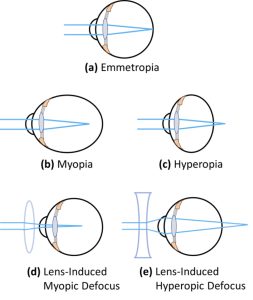Light and Eyeballs
84
Learning Objectives
Know what the causes of myopia and hyperopia are.
Be able to describe how the focus point is affected by myopia and hyperopia.
Know what the current treatments for myopia and hyperopia are (what kinds of glasses, surgery).
Causes of Myopia and Hyperopia
Myopia (near-sightedness) is characterized by blurring of objects viewed at a distance, and is commonly the result of abnormal elongation of the eyeball which causes the refractive image formed by the cornea and the lens to fall in front of the photoreceptors of the retina. It occurs when the axial length of the eye is loo long, and light is focused in front of the photoreceptors. Hyperopia (far-sightedness) occurs when the axial length of the eye is too short, and light is focused behind the photoreceptors. This makes close-by objects appear blurry.
Effects on the Focus Point
The cornea determines whether you are near-sighted or far-sighted because it has 80% of the focusing power of the eye and is not flexible. If the cornea focuses too fast or the eyeball is too long, you are near-sighted (myoptic). If the cornea does not focus strongly enough, light from near objects focuses behind the retina and is blurry, meaning you are far-sighted (hyperopic).
Treatment Options
There are multiple ways to treat both myopia and hyperopia. In the case of myopia, affixing a negative (concave or diverging) lens over the eye pushes the focal place of the visual image behind the retina inducing an increase in axial elongation and a more myopic refraction. With hyperopia, a positive (convex or converging) lens over the eye pushes the focal plane of the visual image in front of the retina, inducing a decrease in axial elongation and a more hyperopic refraction. Besides glasses and contact lenses, another option is surgery. LASIK and LASEK can reshape the cornea to eliminate the need for corrective lenses for near-sightedness, far-sightedness, and other issues.

Exercises
- ___ is characterized by blurring of objects viewed at a distance
A. Myopia (near-sightedness)
B. Myopia (far-sightedness)
C. Hyperopia (far-sightedness)
D. Hyperopia (near-sightedness) - The ___ determines whether you are near-sighted or far-sighted because it has 80% of the focusing power of the eye and is not flexible.
A. iris
B. cornea
C. lens
D. sclera - Which of the following can NOT treat Myopia/Hyperopia
A. LASIK
B. LASEK
C. Contact lenses
D. Blue-Light glasses
Cheryl Olman PSY 3031 Detailed Outline
Provided by: University of Minnesota
Download for free at http://vision.psych.umn.edu/users/caolman/courses/PSY3031/
License of original source: CC Attribution 4.0
Adapted by: Elena ShestWebvision: The Organization of the Retina and Visual System, The Science Behind Myopia by Brittany J. Carr and William K. Stell
URL: https://webvision.med.utah.edu/book/part-xvii-refractive-errors/the-science-behind-myopia-by-brittany-j-carr-and-william-k-stell/
License: CC BY-NC

